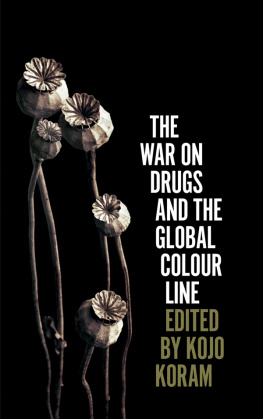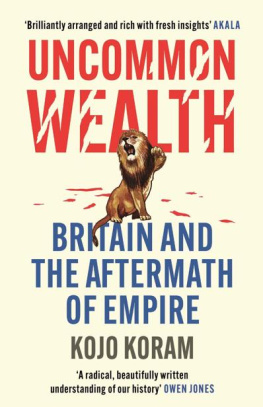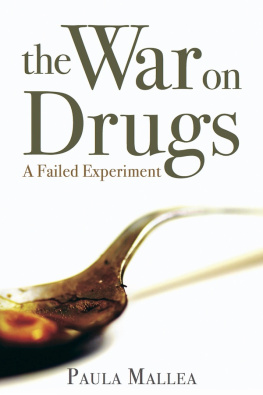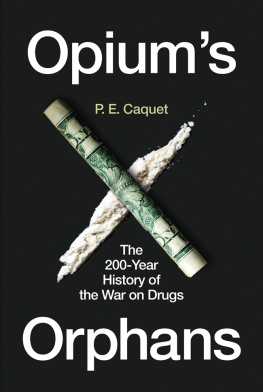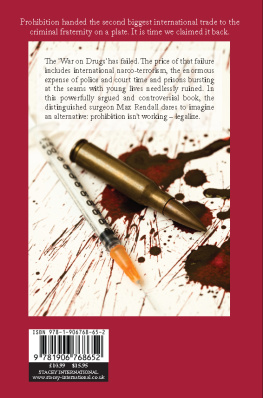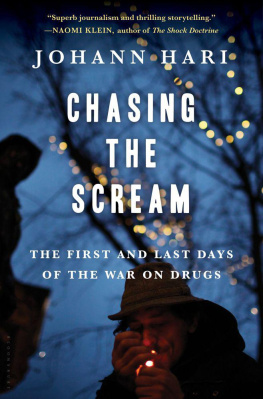Contents
Guide
The War on Drugs and the Global Colour Line
The War on Drugs and the Global Colour Line
Edited by
Kojo Koram

First published 2019 by Pluto Press
345 Archway Road, London N6 5AA
www.plutobooks.com
Copyright Kojo Koram 2019
The right of the individual contributors to be identified as the authors of this work has been asserted by them in accordance with the Copyright, Designs and Patents Act 1988.
British Library Cataloguing in Publication Data
A catalogue record for this book is available from the British Library
ISBN 978 0 7453 3882 8 Hardback
ISBN 978 0 7453 3880 4 Paperback
ISBN 978 1 7868 0408 2 PDF eBook
ISBN 978 1 7868 0410 5 Kindle eBook
ISBN 978 1 7868 0409 9 EPUB eBook
This book is printed on paper suitable for recycling and made from fully managed and sustained forest sources. Logging, pulping and manufacturing processes are expected to conform to the environmental standards of the country of origin.
Typeset by Swales & Willis
Simultaneously printed in the United Kingdom and United States of America
For Yaara
Contents
Acknowledgements
This book is the product of a series of workshops focused on critical approaches to drug policy held at the University of Essex between 20172018. The first workshop was sponsored by the Open Society Foundation and the International Centre on Human Rights and Drug Policy, who both deserve my unending gratitude for supporting this project in its fledging stages. I am deeply indebted to Dr Nayeli Urquiza Haas, my co-conspirator in organising the first conference and a source of endless inspiration for the project as a whole. Also, my heartfelt thanks is extended to Julie Hannah, the Co-Director of the International Centre on Human Rights and Drug Policy, who has been a constant champion of the project and supported us at every turn.
From that initial meeting, I was fortunate to assemble an exciting collection of authors to collaborate on further workshops, including one focusing specifically on race and drug policy. These workshops resulted in the writing of this book. I owe a deep thanks to all of my contributors for being willing to lend their insights to my project in such fascinating ways. It was a real privilege to have curated such an exciting group of authors.
In guiding the book to publication, I was lucky to receive the support of David Shulman and everyone at Pluto Press. Finally, this book would not be possible without the support of my partner, Kim Simpson and the inspiration of my daughter Yaara whose impromptu arrival coincided with my submission deadline, meaning the final drafts of this book were written with one hand whilst carrying a sleeping baby with the other. It is to you, Yaara, that this book is dedicated and hopefully by the time you are old enough to read it, the world will be a different world from the one we describe here.
Introduction
Kojo Koram
In 1903, canonical African-American sociologist W. E. B. Du Bois famously declared that the problem of the twentieth century is the problem of the colour-line. In the nineteenth century, the age of empires reached its apex as European colonial powers competed with each other to control more and more of the globes resources and territory. A racial logic underpinned the European empires behaviour to a greater or lesser extent, with scientific racism giving rise to an idea of a fixed hierarchy between peoples of different skin colour, which could subsequently be used to justify White Europeans claiming dominion over the earth. However, with the twentieth century bringing with it increasing internal crisis within this imperial world order, the age of empires would collapse into global warfare shortly after the turn of the century. In anticipation of this decline of the world of empires, Du Bois correctly recognized that any vision of a new, more universal international order would have to address the question of the colour line that had been drawn across the globe by European imperialism and that in many countries South Africa, Australia and of course Du Boiss own United States of America, for example was explicitly enshrined in law. And yet, despite Du Boiss haunting premonition, by the mid-twentieth century, with the victories of civil rights and decolonization as well as the wider cultural shift away from the accepted norms of scientific racism, the problem of the colour line appeared to have been solved, or at least be set upon a historical trajectory that would lead to it to being solved by the turn of the new millennium.
Now writing from within that new millennium, the idea that the problem of the colour line was effectively concluded with the end of formal colonialism and segregation holds little water. While both the letter of the law and wider cultural discourse disavow racial categorizations, empirical research continues to reveal deep divisions in terms of the treatment of people persisting to operate along racial lines.question by focusing on the late twentieth-century War on Drugs by which we refer to the internationally and domestically enforced prohibition of illegal intoxicants as a contemporary arena in which difference in racialized subjectivity and experiences continue to be produced.
The argument that the drug laws aid in the production and persistence of a colour line challenges the objective ground upon which these laws draw their authority. The laws that prohibit the production, sale and possession of particular drugs are presumed as being politically neutral and grounded in an objective assessment of harm. The United Nations Single Convention on Narcotic Drugs, 1961 (hereafter referred to as the Single Convention), the UN treaty that serves as the bedrock for the current system of international drug prohibition, claims that the prohibition of drugs will prevent social and economic danger for mankind as a whole. However, in the decades of international drug prohibition that have followed, the result of prohibition is primarily untold millions of people being left dead, displaced and/or incarcerated across the world, without producing the targeted drop in the trade of drugs. Furthermore, this suffering has not been endured universally, but instead has been disproportionally borne by specific groups of people, often groups that were already historically oppressed through the preceding racial and colonial organization of the globe. However, while there has been much scholarship and public debate over the past decade that has analysed how the War on Drugs has fuelled a racist system of mass incarceration and state violence in the US, work that shows that this dynamic has also been reproduced right across the world remains underdeveloped. This collection of essays brings together the work of various scholars and policy experts concerned with drugs and race in order to offer an innovative interrogation of the racist impact of the War on Drugs across multiple continents.
The War on Drugs
What was the twentieth-century invention that is commonly referred to as the War on Drugs? Global drug prohibition originated in the twentieth century as a fringe concern of a few religious missionaries and anti-vice moralists and ended the century as an established international legal norm, backed by a global system of militarized enforcement, at the centre of a worldwide network of police power and prison systems. How was such a transformation produced? In a world in which global consensus often appears impossible, drug prohibition could initially appear as a rare Moreover, in addition to explaining this failure to eradicate the drugs trade, those who champion the War on Drugs must also account for the stark racial and geographic asymmetry in terms of who has felt the consequences of prohibition.

